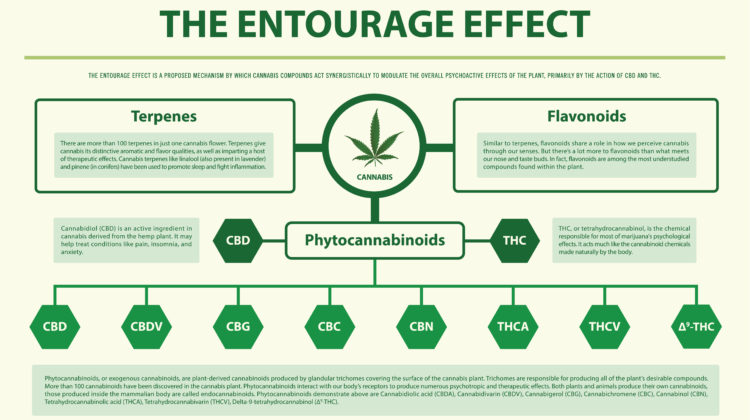
Research on the benefits of combining cannabis compounds, called the entourage effect, will change the way consumers look at cannabis forever. Photo credit: Shutterstock.
When people talk about the over 400 known compounds that comprise the cannabis plant, the two cannabinoid heavyweights, THC and CBD, generally dominate the conversation. But soon cannabis consumers all over will be talkin’ terps, thanks to the entourage effect.
What is the Entourage Effect and how Does it Work?
Far beyond THC and CBD, cannabis contains plenty of different cannabinoids. For example there’s CBN, which has antibacterial and neuroprotective properties, and CBC which produces both antidepressant and analgesic effects.
Additionally, cannabis also contains an array of terpenes — aromatic compounds that give strains their signature smells. Think strains like Lemon Haze, which gets its pungent, citrusy smell from limonene, a terpene known to improve one’s mood and relieve stress.
Each compound has its own properties and effects. For instance, the cannabinoid CBG has anti-inflammatory and antimicrobial properties. The terpene myrcene can act as both a sedative and an anti-inflammatory, according to research published in The British Journal of Pharmacology.
The entourage effect theorizes that when users consume these therapeutic properties together, it may enhance the compounds’ effectiveness, creating a type of cannabis synergy. Dr. Raphael Mechoulam (the chemist who first isolated THC in 1964) and Dr. Shimon Ben-Shabat first coined the term in 1998.
A prime illustration of the effect comes from a 2010 study published in The Journal of Pain and Symptom Management. Patients suffering from cancer-related pain were randomly given either a pure THC extract, or an extract containing similar levels of both THC and CBD. The patients given the combination extract reported suffering less pain than the group given the THC-specific extract.
Some researchers believe that cannabis synergy produced by the entourage effect might also prove useful in treating mood disorders like anxiety and bipolar disorder. However, more research is required, according to Peter Morrell, a professor at the University of Minnesota who teaches a science of cannabis course.
“I think there’s no doubt that there are interactions between compounds, it’s just that the research on that isn’t extensive enough to really know how all those things are going to interact,” he told Emerald.
Harnessing Cannabis Synergy
One of the most thorough reviews of the entourage effect comes from Dr. Ethan Russo — a veteran neurologist and psychopharmacology researcher.
In his 2011 article published in The British Journal of Pharmacology, Russo goes in-depth about the entourage effect’s theoretical benefits.
Cannabis synergy can be harnessed for a wide array of treatments, according to Russo. He states that researchers used the cannabinoid CBD and the terpene limonene in a 2008 efficacy study. They found that the compounds’ anti-inflammatory effects inhibited a key acne-causing pathogen. It did so better than triclosan, an antibacterial and anti-fungal agent commonly used in over the counter skin care products.
Russo also alleges that cannabis synergy can be effective in treating other ailments from depression and anxiety to insomnia and addiction.
A Consumer’s Guide to the Entourage Effect
But not all cannabis products are created equal. Some are more likely to produce the entourage effect than others.
Imagine one day going to a store and hand selecting an extract containing the exact combination of compounds desired. Can’t sleep at night? Consider an extract abundant in CBN and linalool. That old knee injury flaring up again? Try an extract containing CBG and myrcene.
Cannabis flower, a natural choice for many, contains the plant’s natural array of cannabinoids and terpenes. However, with growers focusing considerably more on cultivating strains high in THC, consumers looking for specific cannabinoids and terpenes might also consider extracts.
Extracts come in many forms, from dabs to edibles. Beyond the physical form, there are three categories of extracts. Those include: full-spectrum, broad-spectrum and isolates, according to Honahlee, a guide for medical cannabis.
Full-spectrum extracts contain a long list of richly diverse cannabinoids and terpenes all in one product. Looking for a “catch-all” remedy that is a bit more predictable than flower? Full-spectrum extracts might be a better choice.
Similar to full-spectrum extracts, broad-spectrum extracts offer wide-ranging compound diversity. But they are refined to remove THC, which is great for people looking to find cannabis remedies without the accompanying high.
Isolates take this refining process one step further and contain only a single compound — generally THC or CBD. These isolates are for consumers who want a specific effect, whether it’s inflammation or sleep. Though, as mentioned previously, these isolates may not be as effective as extracts that harness the power of cannabis synergy.
Regardless of whether or not one buys into the power of the entourage effect, according to Morrell, professor at the University of Minnesota, the extract industry is here to stay. And with the power of cannabis synergy on its side, the sky’s the limit.



Leave a Reply